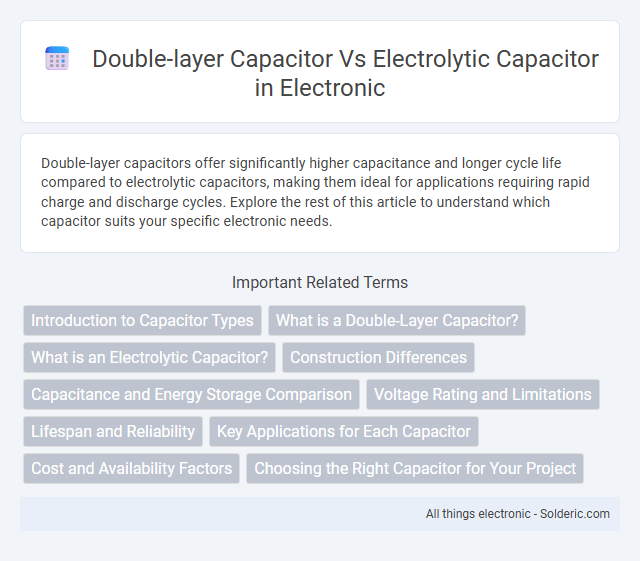Double-layer capacitors offer significantly higher capacitance and longer cycle life compared to electrolytic capacitors, making them ideal for applications requiring rapid charge and discharge cycles. Explore the rest of this article to understand which capacitor suits your specific electronic needs.
Comparison Table
| Feature | Double-Layer Capacitor | Electrolytic Capacitor |
|---|---|---|
| Capacitance | High (up to several Farads) | Moderate (microfarads to millifarads) |
| Voltage Rating | Low (typically < 5V) | Higher (up to several hundred volts) |
| Energy Density | High (1-10 Wh/kg) | Low (0.01-0.1 Wh/kg) |
| Equivalent Series Resistance (ESR) | Low (milliohms) | Higher (ohms to milliohms) |
| Lifespan | Long (> 1 million cycles) | Shorter (1,000 to 10,000 cycles) |
| Charge/Discharge Rate | Fast | Slower |
| Applications | Energy storage, power backup, pulse power | Filtering, decoupling, energy storage in low-frequency circuits |
| Size | Bulkier due to capacitance size | Compact |
| Cost | Higher per capacitance unit | Lower per capacitance unit |
Introduction to Capacitor Types
Double-layer capacitors, also known as supercapacitors, store energy through electrostatic charge separation, offering high power density and rapid charge-discharge cycles. Electrolytic capacitors rely on an electrolyte and a thin oxide layer to achieve high capacitance in a compact form but have lower cycle life and slower response times. Understanding these fundamental differences helps you select the ideal capacitor type for applications requiring either quick bursts of energy or stable, high-capacity storage.
What is a Double-Layer Capacitor?
A double-layer capacitor, also known as an ultracapacitor or supercapacitor, stores energy through the electrostatic separation of charge at the interface between an electrode and an electrolyte, enabling rapid charge and discharge cycles with high power density. Unlike electrolytic capacitors, which rely on a dielectric oxide layer to store energy, double-layer capacitors utilize a large surface area of activated carbon electrodes to achieve capacitances ranging from farads to thousands of farads. These capacitors excel in applications requiring quick bursts of energy and long cycle life, making them ideal for energy storage systems and power backup solutions.
What is an Electrolytic Capacitor?
An electrolytic capacitor is a type of capacitor that uses an electrolyte as one of its electrodes to achieve higher capacitance values compared to other capacitor types. It typically consists of a metal anode coated with an insulating oxide layer, a liquid or gel electrolyte as the cathode, and a metal casing, providing large capacitance in a compact size ideal for power supply filtering and energy storage. The main characteristics of electrolytic capacitors include high capacitance per volume and voltage tolerance, but they generally have shorter lifespans and higher leakage currents compared to double-layer capacitors.
Construction Differences
Double-layer capacitors feature two electrodes coated with activated carbon separated by an electrolyte, creating an electric double layer that stores energy physically without chemical reactions. Electrolytic capacitors consist of an anode made from aluminum foil coated with an oxide layer acting as the dielectric, combined with a liquid or solid electrolyte that participates in chemical processes to store charge. Your choice depends on the application's requirement for high capacitance and long cycle life in double-layer capacitors versus higher voltage ratings and smaller size in electrolytic capacitors.
Capacitance and Energy Storage Comparison
Double-layer capacitors exhibit significantly higher capacitance values, often reaching thousands of farads, compared to electrolytic capacitors that typically range from microfarads to millifarads. This large capacitance enables double-layer capacitors to store and deliver more energy rapidly, making them ideal for applications requiring quick charge and discharge cycles. However, electrolytic capacitors, despite lower energy density, offer greater voltage ratings and are more suitable for long-term, stable energy storage in power supply smoothing.
Voltage Rating and Limitations
Double-layer capacitors typically offer voltage ratings ranging from 2.5V to 3V per cell, requiring series configurations for higher voltage applications, while electrolytic capacitors can handle much higher ratings, often up to 450V. The voltage limitation of double-layer capacitors is primarily due to electrolyte decomposition and electrode stability, restricting their use in high-voltage environments. Electrolytic capacitors, although superior in voltage tolerance, have shorter lifespans and higher equivalent series resistance (ESR), impacting performance under rapid charge-discharge cycles.
Lifespan and Reliability
Double-layer capacitors (supercapacitors) offer significantly longer lifespans, often exceeding 1 million charge-discharge cycles, compared to electrolytic capacitors that typically last between 1,000 to 10,000 cycles. Supercapacitors maintain stable capacitance and low equivalent series resistance (ESR) over extended periods, enhancing reliability in high-frequency and high-temperature applications. Electrolytic capacitors are prone to electrolyte evaporation and dielectric breakdown, leading to reduced lifespan and increased failure rates in harsh environments.
Key Applications for Each Capacitor
Double-layer capacitors excel in renewable energy systems, electric vehicles, and backup power due to their high power density and rapid charge-discharge cycles. Electrolytic capacitors are commonly used in power supply filtering, audio equipment, and signal coupling because of their large capacitance values and cost-effectiveness. Choosing the right capacitor depends on your application's needs for energy storage duration versus instantaneous power delivery.
Cost and Availability Factors
Double-layer capacitors typically have higher initial costs compared to electrolytic capacitors due to advanced materials like activated carbon and manufacturing complexity. Electrolytic capacitors remain widely available and cost-effective for bulk applications, benefiting from established mass production and lower material expenses. Availability of double-layer capacitors is more limited, often specialized for energy storage applications requiring high cycle life and fast charge-discharge performance.
Choosing the Right Capacitor for Your Project
Double-layer capacitors, also known as supercapacitors, offer high capacitance and rapid charge-discharge cycles, making them ideal for energy storage and power backup applications. Electrolytic capacitors provide higher voltage ratings and stable capacitance at lower costs, suitable for filtering and smoothing in power supplies. Selecting the right capacitor depends on the project's voltage, capacitance, size constraints, and application-specific requirements such as energy density or frequency response.
double-layer capacitor vs electrolytic capacitor Infographic

 solderic.com
solderic.com